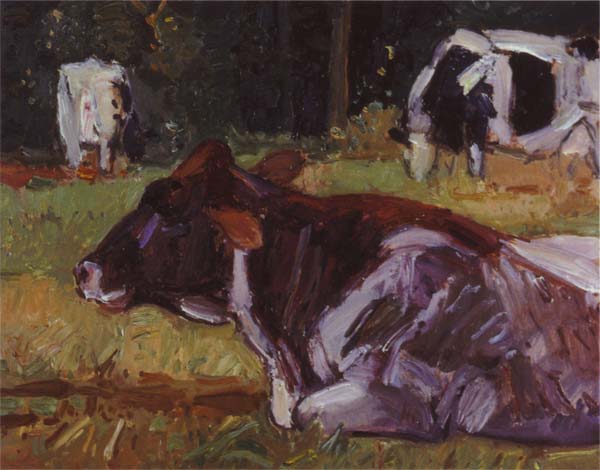
The Heifer, oil on paper on panel, 8 x 10 inches
Sharon Yates is an amazing painter whose primary subject for many years has been small paintings of cows done completely from life. Out of curiosity, I made a Google image search on “cow paintings” to see what other contemporary painters were doing with the subject. There are many, perhaps too many, paintings of cows done in almost every artistic style and genre and level of skill imaginable. But what I didn’t see was paintings made, not from photos, but made while being out in a field actually looking at the cows. Rarer still are cow paintings made from life where the subject isn’t just the cow but also about the act of painting and the paint itself.
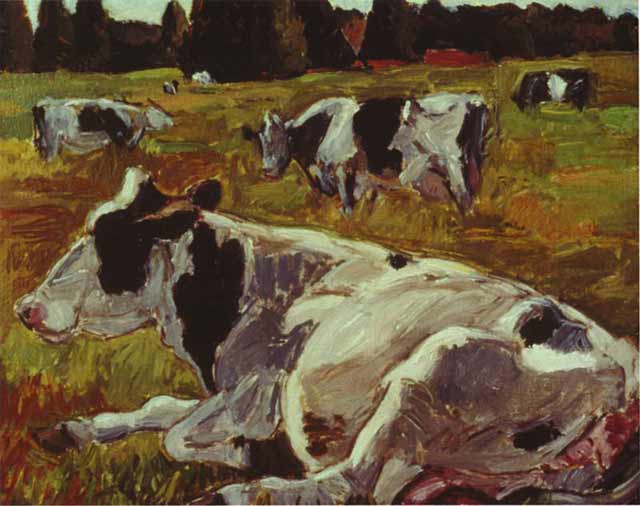
Bell Farm No 1, 2006 , oil on paper on panel, 8 x 10 inches
I would imagine that to properly paint cows from life you’d want a zen-like willingness to let go of control and instead embrace the moment before you. To be here in the now with the cow! I imagine once the cows get used to you they settle down and go off to find there spot which then dictates on some level how the picture evolves. As the cow moves, memory becomes just as important as vision. When painting outdoors you have to deal with the frustration of changing elements that rarely allows you to dictate the terms of your encounter. You must go with the flow of quickly changing light and weather, the torment of insects, and interruptions from all kinds of mammals but to also paint moving cows on top of all this seems madness. But once you no longer resist and embrace the changes that are beyond your control, keeping open to changes and letting the painting be in a constant state of flux until all elements are working together as a whole, the painting then can feel complete in conveying the experience of the artist as well as the observed cow
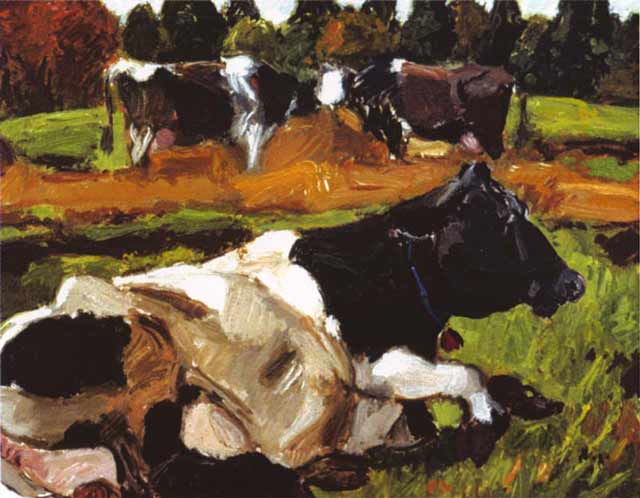
Belty (McPhail’s), 2008 , oil on paper on panel, 8 x 10 inches
In the rush to capture the moment as well as from aesthetic considerations, forms are simplified and modeling is minimal. She paints the cows in a gutsy direct manner that accentuates the gesture of the cow’s pose as well as it’s massive form and weight. Often the pattern of the cows markings echo other elements in the landscape to form a rhythmic connection. Spacial recession seems more defined by overlapping relatively flat planes of color than on atmospheric perspective and suggesting recession into deep space. The direction, weight, speed and energy of her drawn brush marks moves the viewers eye through the picture. The rapid nature of alla prima painting calls for emphatic decision making, there is no time for ambivalence you can only say this is what I experienced, this is what it looked like to me, this is how I felt. The painting’s subject are just as much about cows in a landscape as it is a record of her encounter with nature and with art. She shows us compelling patterns of shapes that happen to be cows as well as the tension between dark and light, big and small, figure and ground, honest response and painterly invention. The small scale of the painting invites the viewer to step closer in a more intimate encounter with quiet, lyrical vision.

Heifer in the Woods, 2008 , oil on paper on panel, 8 x 10 inches
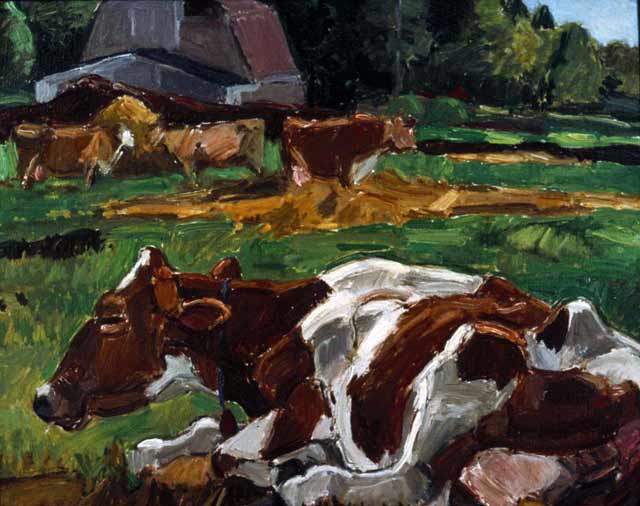
Luxury (McPhail’s), 2008 , oil on paper on panel, 8 x 10 inches
From a review by Philip Isaacson:
Paintings of landscapes with cows are comforting, but don’t offer much in the way of emotional intensity. Paintings of cows in a landscape, on the other hand, can be both a delight and an ever-fresh source of corporeal animation. Those lumpy, bony carcasses can really move when motivated. I’ve learned much of this over time from the small plein air paintings of Sharon Yates. Her work has an immediacy–a sense of nearness–that is almost startling. Yates paints cows in situ, and you can feel it with your eyes. They are right there in front of you, but probably not for long. And that’s part of the wonder of her work. The creatures are apt to wander off before the painting is finished. The cows set the tempo; the painter scrambles after them building their ambulations into the paint. And her surfaces are spellbinding. While the brushwork is as quick as the unpredictable subject matter demands, somehow a luxuriance is contributed to the paint that is almost at odds with pasturing cattle. The elegance of Yates’ hand and the first-glance banality of a ruminating bossy seem to be curious bedfellows. But in time, they settle in. Yates is enchanted by the creatures, and we come to accept them as worthy of her accomplishments as a painter. Her small paintings–that’s what they have to bare a feast for the eye.
Sharon Yates currently lives and paints in Lubec, Maine. After a long tenure of teaching at the Maryland Institute College of Art she retired from teaching in 2007. She has been a visiting artist at the Glasgow School of Art in Scotland, George Washington University and the SACI program in Italy. Her paintings have been exhibited internationally and won her several honors including the Prix de Rome and an Ingram Merrill Foundation Grant. In 2009 her work was included in the National Academy Museum Biennial, NYC where she is an academician member. She shows with the Dowling Walsh Gallery in Maine and currently has work in the the current Zeuxis Common Object at the Lancaster Museum of Art in Pennsylvania. Born in Rochester, NY, Yates holds a BFA from Syracuse University and an MFA from Tulane University.
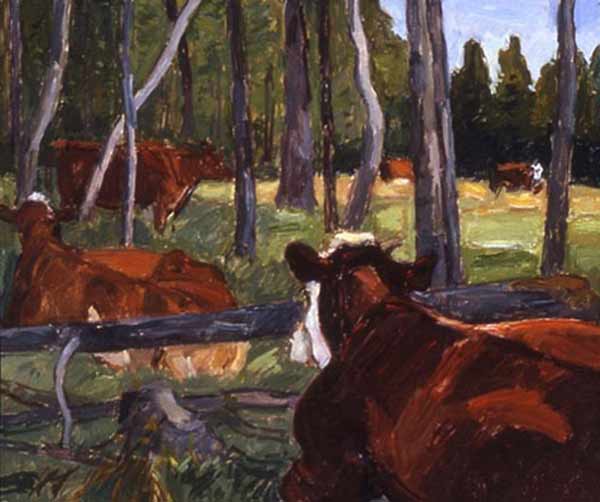
Brown’s Woods No 3, 2004, oil on paper on panel, 8 x 10 inches

Brown’s Woods, 2004, oil on paper on panel, 8 x 10 inches
She also paints watercolors on site, here are a couple of water color drawing she did.
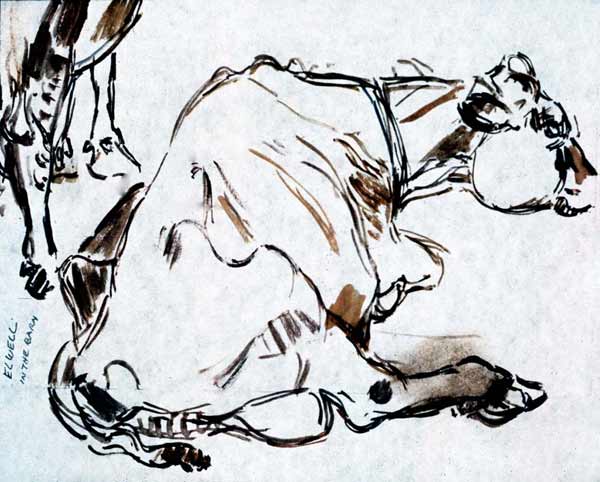
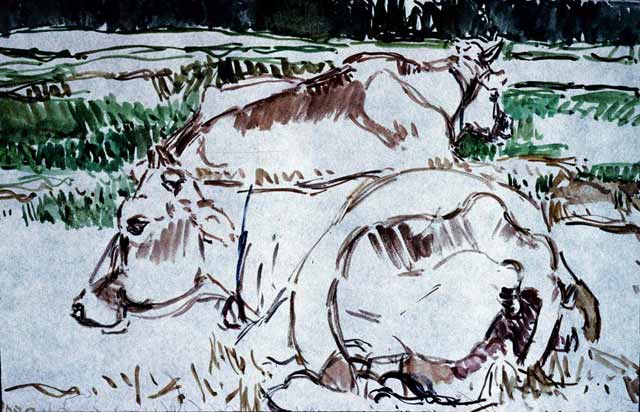
Here are a couple of cow-less landscapes Sharon Yates that you may find of interest.

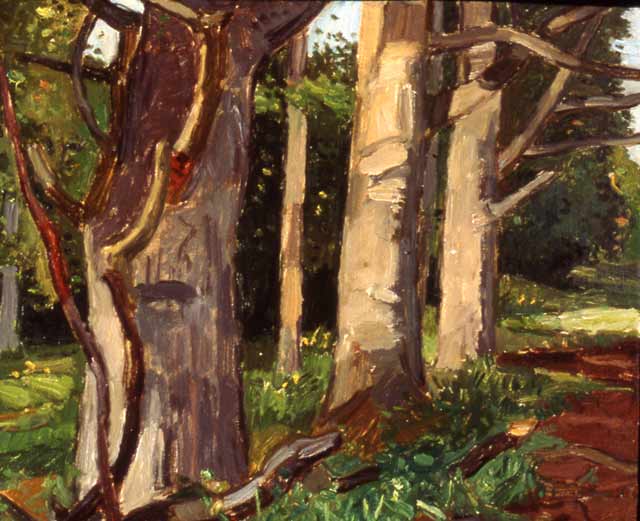
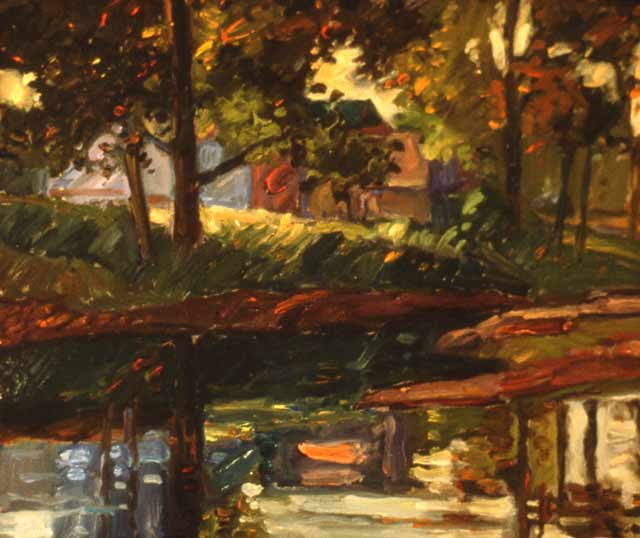




Sharon Yates, living and working in the DC/Baltimore area, shares a strong lineage with Jack Boul, a painter and teacher in his 80’s from Maryland(suburban DC). To my knowledge, he has been painting cows for nearly 50 years. http://www.jackboul.com
Follow-Up: Jack Boul, as a painter and former professor at American University, is connected to older Boston University faculty (Reed Kay and others) on a number of levels.
Interesting. Thanks Ken, for this information I’ll look into Jack Boul and see if I can find anything about him online.
Sharon’s a good painter and been a friend of mine for many years- met her when I started teaching at MICA in 1973. She’s known too for being colorful. For years before she retired from teaching at MICA she spend part of each year working in Maine and part in Baltimore.
Once I greeted her upon her return at the beginning of a new semester after what must have been a difficult summer of painting for her. Asking her how her work had gone, she rolled her eyes in exasperation and snorted ” I tramped all over the state and I can tell you there’s not a goddamned thing to paint in Maine.” Of course she was exaggerating, but I loved the venting of the incredible level of frustration that I think ALL painters have to suffer through from time to time. Not to take pleasure in other’s sorrows, but so often individual artists feel alone with the challenges to their creativity. Everybody goes through hard patches, the real artists are the ones like Sharon Yates who manage to keep going despite that.
This is a richly deserved tribute to one of the finest and most dedicated painters I know.
I live in Lubec Maine. Sharon is my neighbor and friend, but most of all she is my inspiration and one of the most prolific and talented artists I have ever met. I so much enjoyed reading the article on her and her work.
This is wonderful. Sharon is as good a teacher as she is a painter. What she gives to and gets out of her students is truly amazing. Her intensity is matched by her humor; she is the only person that I know who relates to cows on an intellectual level!
Pissarro would have quibbled with Ms. Yates’ shallow space and lack of luminosity. But she has probably dispensed with these phenomena by choice – the better to reveal the specific gravity of her subjects. When I look at her paintings, I don’t see the “envelope of light” that often concerns me, but I do find myself in the presence of the vitality and musculature of living – if ostensibly sluggish – creatures.
I studied with Sharon for several summers in Canada and Virginia. She is a fantastic teacher and has helped me enormously. I really enjoyed finding this wonderful article about her.
I also studied with Sharon at the Maryland Institute, and at one of her summer workshops in Canada. She was such a supportive and tough teacher….Great to see her beautiful paintings here.
sharon is a wonderful painter and one of the best teachers i have had
It’s nice to see the kind comments about my Aunt.
Sharon, This is a lovely tribute to your work. So good to re-connect after all these years!
I knew Sharon from way back in the early seventies. I finished my stay at the American Academy in Rome just as she was beginning hers, and we saw each other in Baltimore. Beautiful paintings here. Thank you for this article and images.
Painting is rarely easy in any way. Or I might say good paintings aren’t easy to make. Struggle is part of a painter’s day. The cows don’t sit still nor do the clouds or the trees, for that matter. That is a given. To make strong and beautiful paintings is a challenge and Sharon does that so well in these.
For the 40+ years that I have been aware of Sharon, I would say that she is and continues to be an outstanding painter.
Furthermore, her work has never been about superficial embellishment nor popular decoration, but instead perceptive visual honesty. Of all the artists that I have been associated with over the past 50 years, I treasure those dialogues (albeit brief) with Sharon, and her search for the visual essence – not unlike Claude DeBussey in music.
Sharon was my instructor as a freshman at MICA in 1968. I took several drawing and painting classes from her over my years there. She was truly inspirational and a dedicated teacher who cared for her students
I must say I am impressed with Sharon’s work. She and her sister are my cousins, who I have not seen in many years. I understand she is being honored in Rochester, NY by her high school in June. It is my hope to be in attendance at this ceremony when she receives this recognition.
I just saw Spns of Sharon’s work
Wow
And I remember her well from our Clasz of 58
Steve Malley